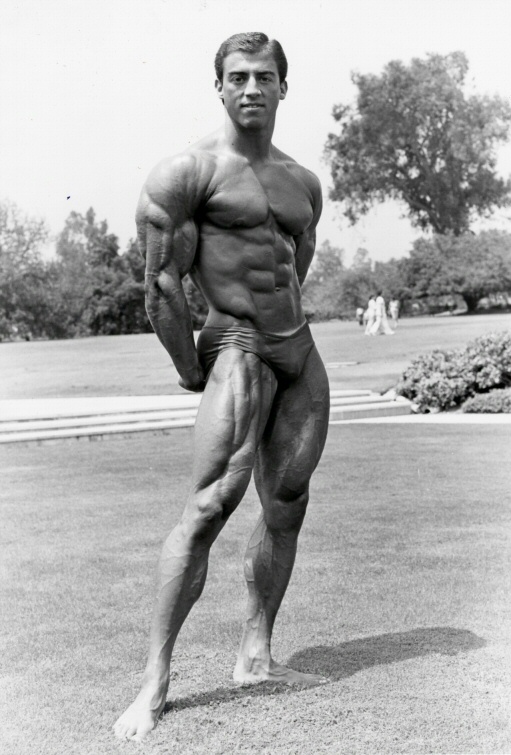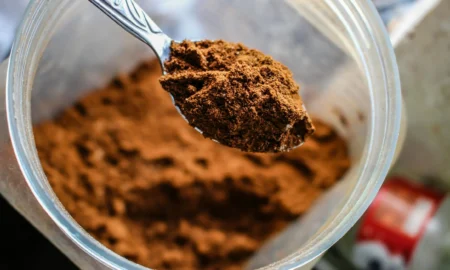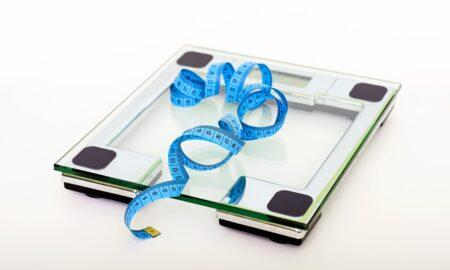The Surreal Journey of Getting Ripped for a Bodybuilding Contest
Please excuse me for departing from my usual theme of biomechanics, but I thought it would be interesting to discuss this phase of my diet, as I am currently in the count-down for two bodybuilding competitions. For those who are unaware, this will be my final year of competing. It will be the culmination of a competitive career that began 35 years ago, when I was just 16 years old (…I began training at the age of 14). At the time of this writing, the first of these final two contests is less than two weeks away; the second contest is about five and a half weeks away.
The Dietary Phases of Bodybuilding Preparation
Preparation for bodybuilding competition typically goes through two phases – a “bulking” phase and a “cutting up” (or getting lean) phase. The difference is primarily in the diet.
During the bulking phase, we eat as many calories as we can – with an emphasis on both protein and “high-glycemic” carbs. The objective here is to use the insulin produced by the high-glycemic carbs to force the dietary protein into the muscle. Although high-glycemic carbs (starches and sugars) tend to make us increase our body fat storage, they also help considerably in making a muscle bigger (…assuming it has been stimulated by heavy weight training). If you try to stay lean all year, by avoiding starches and sugars, you’ll seriously compromise your ability to gain muscle.
Genetics plays a bit of role here: some of us stay relatively lean during the bulking phase, despite eating a high-carb diet. Others, however, tend to gain quite a bit of body fat during this phase. On the flip side – those of us who gain very little body fat during this phase, also tend to gain less muscle, than do our more body-fat-prone counterparts – who tend to gain considerably more muscle during this phase.
During the diet phase, the objective is to lose as much body fat as possible, so that the clarity of the muscle will be maximized. We call this “definition”, or – in the extreme sense – getting “ripped”. During this phase, it’s unlikely we’ll gain much – if any – additional muscle. As mentioned above, without having as much insulin being produced, it’s more difficult to force as much protein into the muscle, and this results in less new muscle being developed. However, it often appears that we’re gaining muscle during this phase, simply because the muscles we have at that point start to become more pronounced. This is because the layer of fat that has been covering the muscle is being reduced, which allows better visibility of the muscle.
This is what’s going on with me right now. My weight is dropping at the rate of about 2-3 pounds per week, but it appears that I’m larger. In fact, I am now about 12 pounds lighter than before I started the diet phase.
How Body Fat Gets Reduced
Body fat is stored fuel. Let’s call it “money in a savings account” – for the time being. During a fuel demand – when you exercise or otherwise increase your level of physical activity – your body goes through a bit of a sequential search for fuel. The first place it searches is the blood stream, where – typically – glucose is swimming around. Let’s call this “money in your pocket”. If there is plenty of money in your pocket, there’s no need to go to the savings account – right ? If you’ve eaten plenty of food, it’s likely there’s plenty of money in your pocket (fuel in the bloodstream). That’s why you won’t lose any body fat until you reduce your intake of calories. The only way to force your body to resort to its stored fuel, is by creating a shortage of fuel (calories) obtained from recently eaten food.
Calories are found in protein, carbs and fats – however, the two primary “fuel” calories are carbs and fats. Protein is not typically used as a fuel in the body. Theoretically, it could be used as a fuel, but it requires much more processing (in the body) in order to become useable as a fuel. Protein is, instead, used mostly for tissue maintenance. As “fuel” – that can be burned to produce energy and movement – the body prefers the calories that come from carbs and fats. But these two aren’t equal players.
At first, it might seem that fat is “worse” than carbs, because fats have 9 calories per gram, and carbs only have 4 calories per gram. However, some (not all) carbs have one problem that over-rides the fact that they have fewer calories per gram – they make the body produce insulin. Calories can easily be spent, whether they come from fats or carbs, but insulin cannot be peddled away on a Lifecycle. Insulin is not a “spendable” calorie.
Insulin tends to block fat loss (i.e., protects body fat), and also helps facilitate additional fat storage – even when there’s a calorie shortage. As an example, a person could eat 1,000 calories per day, and lose very little body fat – if those thousand calories are comprised partly (or mostly) of foods like rice and pasta. On the other hand, a person could lose MORE body fat, while eating 1,500 calories per day – if those calories are void of starches and sugars.
Foods that contain starches and sugars are considered “high-glycemic” carbs; they include potatoes, rice, bread, sugar, many (but not all) fruits, most cereals, etc. “High-glycemic” refers to a scale called “The Glycemic Index”, which rates foods between 1 and 100, and whose rating is above 70. The higher the rating, the more likely it is that food will produce an insulin rise in your body. “Low-glycemic” carbs are the ones that typically rate below 30 or so (these include most vegetables, high-fiber legumes, berries, etc.).
So the trick is to first reduce or eliminate the high-glycemic carbs, and eat primarily the low-glycemic carbs (from veggies), plus protein and a little bit of fat. Then, little by little, you reduce the calories from those sources too.
Body Fat and Glycogen
Assuming you have now eliminated all the starches and sugars from your diet, and are eating only protein foods, a little bit of dietary fat (from nuts, olive oil, meat, dairy), and vegetables – your body will find itself in need of using its stored fuel, to make up the difference between what you’re burning (to fuel your workout, as well as your other daily activities) – and what you’re eating.
Your body has two “savings accounts” of fuel – body fat and “glycogen“. Glycogen is carbohydrate that we have stored in our muscles (and, to a lesser degree, in our liver). Unfortunately, we cannot direct our bodies to burn ONLY body fat. When a body senses a shortage of fuel, it will pull from both of these sources. Naturally, we’re happy about the fact that our body fat reserves are being “spent”; but we’re not so happy about the fact that our glycogen reserves are also being spent. Why? Because glycogen contributes quite a bit of size to our muscles.
The average muscle is said to be about “70% water” (by weight). This is a reference to the fact that a normally hydrated muscle….one that is holding a normal amount of glycogen….is holding “X” amount of water, with that glycogen. Therefore, when we lose muscle glycogen – by having spent it as part of the fat loss process – we lose a percentage of our muscle size. Or so it seems. Naturally, this is very disconcerting to a bodybuilder – especially when he (or she) is preparing for competition. We don’t want to lose ANY muscle size; in fact – we want more muscle, not less.
Sorry to be the bearer of bad news. You cannot lose body fat without losing some glycogen, and therefore some muscle size. Further, the lower your body fat gets, the more glycogen you lose. Actually, to be more precise, the more glycogen-depleted you become, the more you will burn body fat…which is good. But, as you lose more glycogen, your muscles become more dehydrated and smaller. The apparent muscle-size loss is temporary, but this is where it becomes a mind game for a bodybuilder.
Getting Lean vs. Getting Ripped
I learned a long time ago that getting ripped requires “under-cutting”, and then coming UP to your contest weight. Most people diet down to their contest weight – and they never really get ripped. Getting ripped requires digging deep. It requires putting your body into a temporary state of crisis, and then bringing it back.
In 1982, when I was preparing for the Mr. California contest, I was determined to be “shredded” (another descriptive for being super lean). I dieted very strictly, and ignored the fact that I was getting smaller and smaller. This – it turns out – was remarkably wise. I don’t know how, at such a young age (22), I was able to stick so steadfastly to the plan, without fearing that I was “over-doing it”, and losing too much muscle. But somehow, I was unflinching. Yes – I most certainly entered that deep, dark place. At times, it seemed like I was a walking zombie. But I did what I had planned to do – to force every ounce of fat from my body, by undercutting my weight, and then carb-loading up to a healthier and fuller weight by contest time.
The same thing happened in 1986, when I was preparing for the Mr. America competition. I dieted so hard, that my cheeks hollowed out, and I got that drawn “concentration camp” look to my face. Before each of these two contests, I was approached by friends who were seriously concerned, and asked if I was “okay”. One person actually said I looked “terrible”, and then I won first place in my division of Mr. America a week later (after carb-loading, of course). Looking “drawn” and depleted a week or two before a bodybuilding contest, is a normal part of getting ultra lean.
The Abyss
That Deep, Dark Place – is a combination of extreme physical fatigue, hunger, concern that you’re losing “too much” muscle, and a change of brain function. It’s a self-imposed period of calorie deprivation and intense physical demand, intended to maximally reduce one’s level of body fat, but which – unfortunately – also produces both physical and psychological challenges.
During this period, there is a shift in the way life is perceived. I’m sure some who are reading this article know exactly what I’m talking about. Frankly, I find it interesting – both, the fact that our brains think differently when they’re hungry, as well as the fact that millions of people probably experience that type of brain hunger on a daily basis – due to economic conditions or other circumstances unrelated to bodybuilding. In any case, if there is a way to get super ripped without going through that Deep, Dark Place – I don’t know about it. It is a rite of passage.
I don’t necessarily dread going through this pre-contest suffering. It’s definitely not easy, but – ironically – there are aspects about it that I like. For one thing, it makes me feel more deserving of a prize. For another, I feel that it is a sort of threshold that few people have the courage to cross. So those of us who do, are members of a unique – and somewhat elite – community. I also like analyzing the shift in perspective. Suddenly, it seems that things become more black and white. Pretense becomes more obvious. It’s almost as if Maslow’s Hierarchy of Needs kicks in, and things separate into the “important” and the “unimportant”… the things of consequence, and the things that are not of consequence. That’s the good part.
The bad part is that it plays havoc with one’s mood. It tends to cause a loss of confidence, at a time when we need the most confidence. It also causes a drastic reduction of one’s energy level, precisely when we need the most amount of energy – so that we can train super hard. At a time when we need to be the most motivated, we feel the least motivated and the most tired.
I’m in that place right now. Some days I feel good – physically and mentally – and other days not so much. Some days I feel that I’m right on track; other days I’m not so sure. Fortunately for me, I have a historical reference. I can look back and recall what I’ve done in the past, and reflect on how it worked back then. But even still, this phase of the diet messes with one’s mind, in addition to being physically difficult. The trick is to rely on your plan, and not re-evaluate it every day.
The Facts
Those who know me, know that I cling to factual information and logic, when the tendency might be to make emotional decisions. Here are some basic bits of information that help me survive this phase. I think they will help others as well.
1. Holding back on one’s diet, because one is afraid to diet “too much” (i.e., lose too much weight), is a bad strategy. When one is leaner, they look bigger on stage – ironically. A person who weighs 185 lbs., and is ripped, will appear bigger (in addition to being better overall), than he would at 195 lbs., not ripped.
2. Too many people wrongly believe they’re “holding water”, when – in fact – they’re still too fat. Often, we hear bodybuilders talking about “getting dry” – a reference to the somewhat foolish notion that losing one’s water is the key to getting “razor sharp”. So, they take a diuretic or stop drinking water – or both. This is a big mistake. The end result is that they are still “too fat”, but then also dehydrated – which causes dizziness, cramping and a further loss of muscle size. Stop blaming water, and diet harder.
3. Most people look better 2 or 3 days after a bodybuilding contest. This demonstrates that they didn’t carb-load enough before the contest. Make this part of the plan. Diet hard; ensure that you have reduced your body fat as much as possible; ensure that you are carb-depleted; and then carb-load for 2, 3 or even 4 days before your contest (depending on how depleted you are).
4. There are two things, primarily, that contribute to muscle size: fiber thickness (i.e. protein) and glycogen (and the water that it holds). When it seems that you’re losing too much muscle, remind yourself that you’re not losing fiber thickness; you’re only losing water (from the muscle), which can easily be brought back with sufficient carb-loading.
5. As long as your protein intake is high, and you continue lifting heavy, you are ensuring that your muscle fibers have what they need to maintain their thickness.
6. You cannot get ripped without experiencing a temporary muscle shrinkage. Don’t be afraid of it. Go with it. Allow it to happen. Stick with your plan. What matters is that you look your best on the day of the contest; how you look in the weeks that come before the contest, matters very little (…for someone whose goal is to compete successfully in a bodybuilding contest).
Don’t allow yourself to make an emotional – or an irrational – decision, while dieting for a contest. Cling to the facts above, and you’ll maximize the odds of doing well in your show. Avoiding that Deep, Dark Place – when the diet gets really rough, the workouts get super tough, and the mind starts to plays tricks on you – will only result in you looking less good on the day of your competition. By the time your diet phase starts (usually 12 weeks out, or so), forget about gaining new muscle. Think ripped.
. . . . . . . . . . . . . . . . . . . . . . . . . . . . . . . . . . . . . . . . .
Note: I am not advocating that everyone pursue this path. There are certainly more reasonable dietary plans, for those interested in “everyday fitness”. This strategy is intended exclusively for those who are trying to prepare optimally for bodybuilding competition. However, a less drastic version of this method could be effectively employed by those with more moderate weight loss goals.
. . . . . . . . . . . . . . . . . . . . . . . . . . . . . . . . . . . . . . . . .

Doug Brignole, at age 22




















12 Comments
You must be logged in to post a comment Login